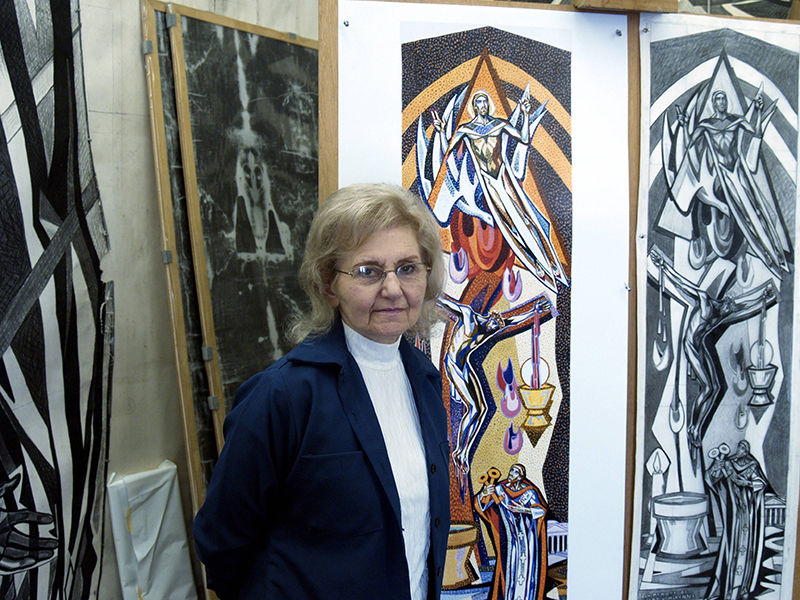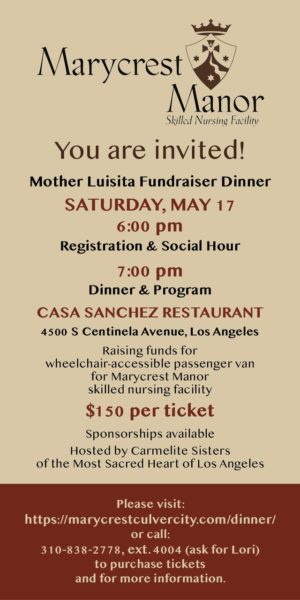Before reflecting on Isabel’s singular contributions on our lives here in Southern California, may I speak about the combined Piczek imprint on Old Planet Earth? I say that because these two artists are almost inseparable, both in time and talent.
As I look back on my priestly ministrations along California’s El Camino Real, nothing stands out more prominently than my acquaintance with Isabel Piczek and her late sister, Edith.
These good people, surely among the most outstanding ecclesial artists of contemporary times, were motivated by the realization that art speaks a message for all humankind.
From their modest and unobtrusive studios in the Echo Park district of Los Angeles, these Hungarian-born artists produced some of the finest murals, mosaics and stained glass in America and Europe.
The Piczeks inherited their talent from their father, an art professor of considerable renown in one of Hungary’s leading universities.
They completed their training in the School of Fine Arts in Budapest. Shortly after the communists took over their homeland, the sisters escaped to Vienna.
Later, they literally painted their way across war-torn Europe, finally arriving in Rome at the outset of the 1950 Holy Year. In the Eternal City, Isabel and Edith won the celebrated Gallery di Roma prize and were commissioned to create a 377-square-foot fresco mural at the Pontifical Biblical Institute, an unheard of distinction for women.
At the invitation of the Canadian hierarchy, the sisters set up studios in Hamilton and Toronto. Then in 1955, they came to the United States where their first commission was a 2,880-foot mural for the cathedral at Reno.
Since 1958, the Piczeks have lived and worked in Los Angeles at their Construction Art Center with artistic masterpieces adorning 450 churches, convents and public buildings on three continents and in seven countries.
Probably the most celebrated of their many works are the stained-glass windows, murals and mosaics at Guardian Angel Cathedral in Las Vegas. Within walking distance from the Strip on Desert Inn Road is the masterful 10-year project titled “Toward the Total Christ.”
Locally, Piczek art can be seen at St. Phillip Church (Pasadena), St. Mary Magdalen (Camarillo), St. Victor (West Hollywood), St. Bridget of Sweden (Van Nuys), St. Catherine Laboure (Torrance) and Our Lady of the Assumption (San Buenaventura).
Their talents have a decided ecumenical attraction, too. The Air Force Chapel at Nellis Air Base, Messiah Baptist Church and B’nai David Synagogue in Los Angeles are perhaps the three finest examples of their outreach and award-winning art.
Here at San Fernando, Rey de Espa√±a Mission, we are surrounded by the artistic beauty of the Piczeks. From the giant portrayal of Pope John Paul II’s arrival in 1987 (over the entrance to the church), to the mural of Our Lady of the Archives (on the northern wall of the Archival Center), to the six panels outlining the history of the Archdiocese of Los Angeles, to a stained glass window over the choir loft of the Church, to the dozens of cartoons and assorted expressions of beauty adorning the walls of our other buildings, visitors are daily reminded of the Piczek genius for expressing their devotion to Almighty God.
Over the years, Isabel and Edith described their “aesthetic partnership” in terms of a “mystical realism” which they looked upon as part of the modern visual and spiritual revolution in ecclesial art. The unassuming sisters saw their vocation as a “cultural and religious mission.”
Feeling compelled to be “always moving forward,” they were ever concerned that the old ways will disappear or trap those who insist on a piety not in keeping with the times.
Believing that much of modern art has a dehumanizing effect, the Piczek sisters portrayed the destiny of humankind in forms of glass, paint and tile, while acknowledging that authentic artwork is implanted on the soul of the observer. And that’s a philosophy almost as beautiful and attractive as their works of art.
Edith went home to the Lord four years ago and early on the morning of Sept. 28 — the feast of the Archangels — Isabel joined her half-sister before the throne of Almighty God.
How appropriate it was that her going forth from Old Planet Earth occurred on that angelic feast day. Always the angels were a part of her artistic expression.
Someone observed that had there been a fourth archangel, it would have borne the name Isabel.
It was my pleasure and privilege to have known these two remarkable ladies for well over a half century. What an honor it has been to witness their unique contribution to the artistic history of the Roman Catholic Church around the world!
Isabel literally prayed her way though her long and productive life in the sense that everything she did was an expression of her profound faith and devotion.
Whether it was her murals, her stained glass or her ceramic tile, Isabel imprinted her unique style on the figures that came from a lifetime of devotion and dedication to the spiritual life.
Happily, I can disclose that a book is now being prepared outlining the artwork of these fine ladies. Surely it will be a finer tribute than I could give on such an occasion as this.
Today we come to pray and thank Almighty God for these two artistic comets who have brightened the life of a world left far better by their presence.
Isabel and her late sister were pioneers not only in the world of artistic creations, but in their very way of life.
Once when I chided Isabel about her scholarly defense of womanhood, she pulled out a copy of Time magazine which repeated the classic version of the creation story.
“Lord, I need a companion,” said the first man on earth. So God took the beauty of a flower, and the song of a bird, the color of a rainbow, the laughter of a wave, the gentleness of the lamb, the cunning of the fox, the fickleness of the showers and waywardness of the clouds and wove them into a female which he gave to man.
And the woman’s name was “Eve.” Or was it “Isabel”?
Interested in more? Subscribe to Angelus News to get daily articles sent to your inbox.

